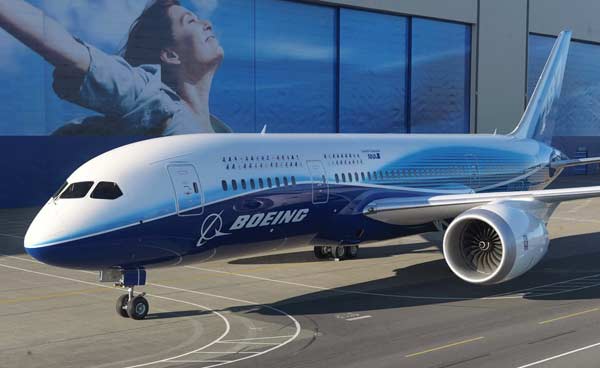
By now every kid nows, that the largest passenger jet constructor in the world is no longer the aircraft giant Boeing with its legendary 747, but Airbus with its gigantic A380. – Not to be mixed up with the largest existing aircraft, the Russian Antonov 225. – Nonetheless Europe will not beat the company once built by lumberjack William Boeing: In the Northwest of the USA at the gateways of the technology metropolis Seattle stands the world's biggest building with a volume of 13.3 million cubic meters and a face of nearly 40 hectares: Everett's Boeing manufactory.



The Dreamliner, price tagged around 125 million Dollars, should help Boeing to be the number one in the sky once again as the "dream airship" of the 21st century. The 787 will be the first passenger jet made of a hull spun with very solid, super light carbon fiber. Proudly the project's spokesman Andrew Magill demonstrates us on the 787-prototype, how the black super duty mega tube rotates around a huge jackscrew, where layer after layer of the wonder substance is being applied: "Together with our subsidiary company Phantom Works we have developed a process, that makes the new composite construction method not more expensive than the previous one." This way a monocoque forms out of one piece – like the driver cabins of the Formula One race cars – which is practically baked afterwards in a special oven and should protract the new jets' service life from actually 30 to 40 years to up to 70, 80 years.

An obvious advantage of the new construction method for future passengers: The outboard wrapping of the Dreamliner is much firmer than those normal aluminum bodies, so the windows can be built reasonably bigger. Also during flight, cabin humidity can be significantly increased for the passenger's benefit, because unlike aluminum the released water will not harm the carbon fiber. Andrew Magill: "During normal long-distance flights in around 10.000 meters height an abnormal atmospheric pressure is standard in the cabin, matching approximately 2400 meters height of a mountain top. This causes breathlessness and headaches for many passengers and makes it hard for them to fall asleep. Inside the ,Dreamliner' we can increase the atmospheric pressure in a way, that is comparable with a sea level of 1800 meters. Thus from a word for word viewpoint the 787 will really become a flying "dream" ship, even capable of simulating sunrise and twilight by means of the aircraft's lighting, which will help the passengers to adjust more easily to their destination's time zone."
Even the little country of Austria is significantly involved in this revolution of aircraft construction. FACC (Fischer Advanced Composite Components) a company with a domicile in Ried (Upper Austria) has been building light modules of carbon for many years as a specialist for the aviation industry. Austrian technology will actually make the turbines of the Boeing 787 more silent. And in the new giant Airbus A380 and Boeings 777 you will also find high-tech made in Austria.
Composite modules like the ones used in the Dreamliner (ca. 50 percent) in such big amounts for the first time, are admittedly not so easy to recycle. Until now special companies have only been able to recycle them in appliances like bulletproof vests. But also here, experts have found ways which are still improvable in the next years, until the delivery of the first Dreamliners (after delays) in 2009. And until the first 787 has to be scrapped effectively, it should still take another 70 years



0 comments:
Post a Comment